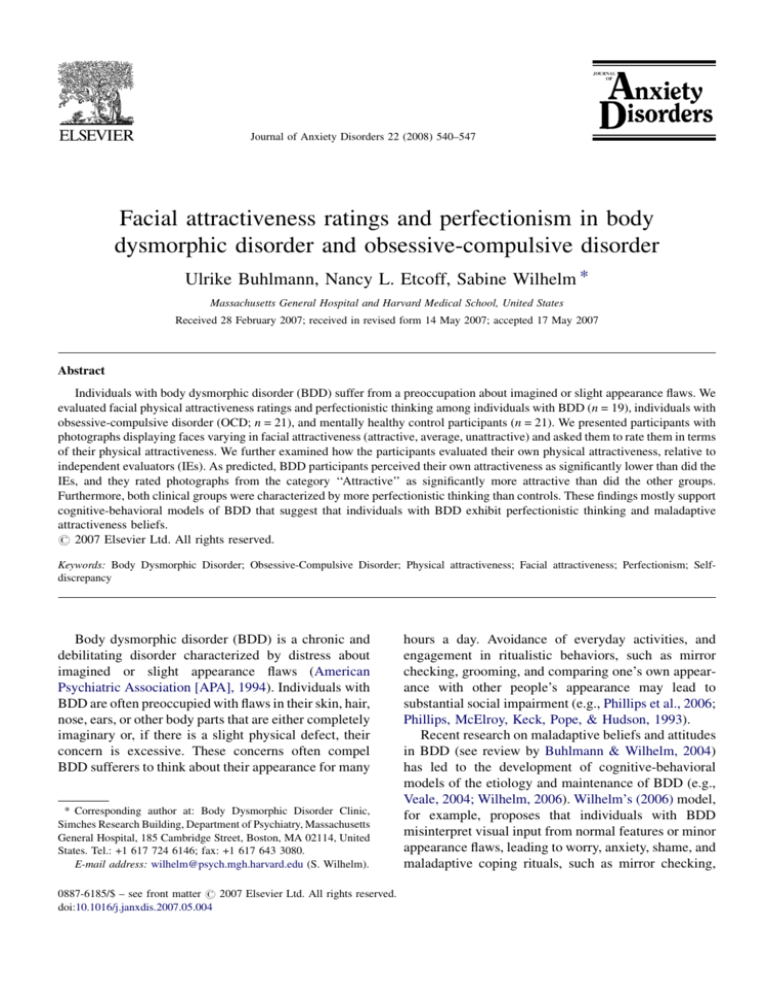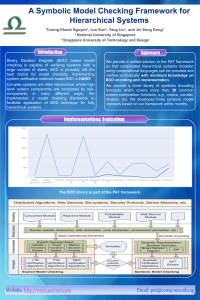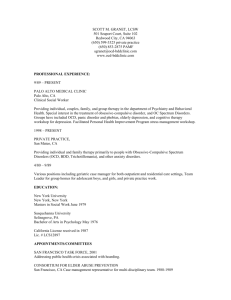
Journal of Anxiety Disorders 22 (2008) 540–547
Facial attractiveness ratings and perfectionism in body
dysmorphic disorder and obsessive-compulsive disorder
Ulrike Buhlmann, Nancy L. Etcoff, Sabine Wilhelm *
Massachusetts General Hospital and Harvard Medical School, United States
Received 28 February 2007; received in revised form 14 May 2007; accepted 17 May 2007
Abstract
Individuals with body dysmorphic disorder (BDD) suffer from a preoccupation about imagined or slight appearance flaws. We
evaluated facial physical attractiveness ratings and perfectionistic thinking among individuals with BDD (n = 19), individuals with
obsessive-compulsive disorder (OCD; n = 21), and mentally healthy control participants (n = 21). We presented participants with
photographs displaying faces varying in facial attractiveness (attractive, average, unattractive) and asked them to rate them in terms
of their physical attractiveness. We further examined how the participants evaluated their own physical attractiveness, relative to
independent evaluators (IEs). As predicted, BDD participants perceived their own attractiveness as significantly lower than did the
IEs, and they rated photographs from the category ‘‘Attractive’’ as significantly more attractive than did the other groups.
Furthermore, both clinical groups were characterized by more perfectionistic thinking than controls. These findings mostly support
cognitive-behavioral models of BDD that suggest that individuals with BDD exhibit perfectionistic thinking and maladaptive
attractiveness beliefs.
# 2007 Elsevier Ltd. All rights reserved.
Keywords: Body Dysmorphic Disorder; Obsessive-Compulsive Disorder; Physical attractiveness; Facial attractiveness; Perfectionism; Selfdiscrepancy
Body dysmorphic disorder (BDD) is a chronic and
debilitating disorder characterized by distress about
imagined or slight appearance flaws (American
Psychiatric Association [APA], 1994). Individuals with
BDD are often preoccupied with flaws in their skin, hair,
nose, ears, or other body parts that are either completely
imaginary or, if there is a slight physical defect, their
concern is excessive. These concerns often compel
BDD sufferers to think about their appearance for many
* Corresponding author at: Body Dysmorphic Disorder Clinic,
Simches Research Building, Department of Psychiatry, Massachusetts
General Hospital, 185 Cambridge Street, Boston, MA 02114, United
States. Tel.: +1 617 724 6146; fax: +1 617 643 3080.
E-mail address: wilhelm@psych.mgh.harvard.edu (S. Wilhelm).
0887-6185/$ – see front matter # 2007 Elsevier Ltd. All rights reserved.
doi:10.1016/j.janxdis.2007.05.004
hours a day. Avoidance of everyday activities, and
engagement in ritualistic behaviors, such as mirror
checking, grooming, and comparing one’s own appearance with other people’s appearance may lead to
substantial social impairment (e.g., Phillips et al., 2006;
Phillips, McElroy, Keck, Pope, & Hudson, 1993).
Recent research on maladaptive beliefs and attitudes
in BDD (see review by Buhlmann & Wilhelm, 2004)
has led to the development of cognitive-behavioral
models of the etiology and maintenance of BDD (e.g.,
Veale, 2004; Wilhelm, 2006). Wilhelm’s (2006) model,
for example, proposes that individuals with BDD
misinterpret visual input from normal features or minor
appearance flaws, leading to worry, anxiety, shame, and
maladaptive coping rituals, such as mirror checking,
U. Buhlmann et al. / Journal of Anxiety Disorders 22 (2008) 540–547
excessive grooming behaviors, frequent asking for
reassurance, or comparing their own appearance with
others’. According to this model, most people dislike
some aspects of their appearance, but individuals with
BDD focus on these details, exaggerating their
perceived or slight defects in appearance. Moreover,
Wilhelm (2006) states that individuals with BDD have
maladaptive beliefs about their attractiveness, such as
higher attractiveness standards and perfectionistic
thinking, which lead to a negative self-evaluation and
low self-esteem. Moreover, higher levels of perfectionism may partly explain why individuals with BDD focus
excessively on, and suffer from, their ‘‘imperfect’’
appearance.
According to the self-discrepancy theory (Higgins,
1987), discrepancies between the actual self and the
‘‘self-guides’’ (ideal and ought/should self) are expected
to result in negative emotions. Thus, given that
individuals with BDD often compare their own
appearance with that of others (e.g., Wilhelm &
Neziroglu, 2002), it is possible that perfectionistic
thinking and discrepancies between one’s own perceived
attractiveness and the perceived ‘‘ideal looking appearance’’ lead to more unfavorable social comparisons with
others. This, in turn, may result in more negative
emotions and low self-esteem. Initial support for this
hypothesis has been reported by Veale, Kinderman,
Riley, and Lambrou (2003) who observed that individuals with BDD exhibited significant discrepancies
between their actual self and their ‘‘ideal’’ and ‘‘should’’
selves. So far, the current models of BDD are
predominately based on clinical observations. While
there is some evidence that attention, interpretations of
situations as well as emotion recognition are biased in
BDD (e.g., Buhlmann, Etcoff, & Wilhelm, 2006;
Buhlmann, McNally, Etcoff, Tuschen-Caffier, & Wilhelm, 2004; Buhlmann, McNally, Wilhelm, & Florin,
2002; Buhlmann et al., 2002) and that individuals with
BDD suffer from low self-esteem (e.g., Buhlmann,
Teachman, Gerbershagen, Kikul, & Rief, in press;
Phillips, Pinto, & Jain, 2004), it has not yet been shown
if they see themselves as unattractive or as ‘‘not attractive
enough.’’ Furthermore, it has not been evaluated how
individuals with BDD evaluate the appearance of others.
These questions relate to the broader concept of
perfectionism. Higher levels of perfectionism have been
found in a series of disorders, such as depression (e.g.,
Enns & Cox, 1999; Hewitt & Flett, 1993; Hewitt, Flett, &
Ediger, 1996), eating disorders (e.g., Halmi et al., 2005;
Shroff et al., 2006), obsessive-compulsive disorder
(OCD; e.g., Frost & Steketee, 1997), and social phobia
(e.g., Ashbaugh et al., 2007; Juster, Heimberg, Holt, &
541
Frost, 1996), supporting the idea that perfectionism is
associated with psychopathology. Moreover, it has been
found that individuals with BDD endorse beliefs, such as
‘‘I have to have perfection in my appearance’’ (Veale
et al., 1996).
To our knowledge, facial attractiveness ratings and
perfectionism have not yet been examined in BDD. In
the current study, we investigated whether BDD
sufferers exhibit higher levels of perfectionism than
control participants. Further, we investigated whether
BDD participants exhibit idiosyncratic or stricter
ratings for physical attractiveness than control participants (and in particular whether these standards apply in
general or only for themselves). Additionally, we
investigated whether these phenomena are typical only
for BDD or whether they characterize a broader
spectrum of psychological disorders, such as OCD.
Based on clinical observations that BDD sufferers are
often characterized by thoughts, such as ‘‘As long as I
don’t look perfect, I won’t be able to be happy,’’ we
expected that BDD participants would show levels of
inflated perfectionistic thinking, as has been shown in
previous research in OCD (e.g., Frost & Steketee,
1997). However, because OCD is not characterized by a
preoccupation with one’s physical appearance, we
hypothesized that OCD participants, unlike BDD
participants, would exhibit attractiveness ratings similar
to mentally healthy control participants.
1. Method
1.1. Participants
The BDD group was comprised of 19 participants (six
men) who met current DSM-IV (APA, 1994) criteria for
BDD as determined by structured clinical interviews
(Structured Clinical Interview for DSM-IV – Outpatient
Version [SCID]; First, Spitzer, Gibbon, & Williams,
1995). The BDD participants had one or more of the
following concerns: facial skin (n = 14), hair (n = 5),
breasts (n = 1), eyes (n = 1), and shape of nose (n = 1).
Although the BDD was the primary diagnosis in all cases
(based on symptom severity), some BDD participants
had the following co-morbid diagnoses: major depression (n = 7), agoraphobia without panic disorder (n = 1),
and social phobia (n = 1). Thirteen BDD participants
were on a stable dose of psychotropic medication at the
time of testing: fluoxetine (n = 7), paroxetine (n = 2),
fluvoxamine (n = 3), and clomipramine (n = 1).
The OCD group was comprised of 21 participants
(10 men) who met current DSM-IV (APA, 1994) criteria
for OCD as determined by the SCID (First et al., 1995).
542
U. Buhlmann et al. / Journal of Anxiety Disorders 22 (2008) 540–547
The participants had one or more of the following
symptoms: contamination fears (n = 9), aggressive
obsessions (n = 5), sexual obsessions (n = 2), fear of
making mistakes (n = 1), obsessions about guilt (n = 1),
religious obsessions (n = 1), rumination (n = 1), checking (n = 15), hand washing (n = 9), counting compulsions (n = 2), hoarding (n = 1), and rereading (n = 1).
Although the OCD was the primary diagnosis in all
cases (based on symptom severity), some OCD
participants had the following co-morbid diagnoses:
major depression (n = 2), alcohol abuse (n = 1), panic
disorder without agoraphobia (n = 1), and chronic
motor tic (n = 1). Nine OCD participants were
unmedicated at the time of testing. The remaining 11
participants were on a stable dose of the following
psychotropic medications: fluoxetine (n = 4), paroxetine (n = 3), sertraline (n = 3), and fluvoxamine
(n = 1). Data on medication status were missing for
one OCD participant.
The mentally healthy control group consisted of 21
participants (nine men). SCID interviews confirmed the
absence of any psychiatric history. As evident from
Table 1, the groups did not differ with respect to age and
education, ps > .83, and gender, x2(2) = 1.1, p = .58.
All of the participants were Caucasian. The patients
groups were recruited at the OCD Clinic at the
Massachusetts General Hospital (MGH). Control
participants were recruited through flyers posted in
the Boston community. All participants were native
English speakers.
2. Material
2.1. Stimulus set
The experimental material consisted of 36 black and
white head-shot photographs of individuals with neutral
facial expressions. All photographs used in this study
displayed Caucasian faces. Photographs were standardized by isolating the face in an ellipse and graying out
the surrounding head, neck, and shoulders. The photos
were taken of 18 females and 18 males who varied in
physical attractiveness (six attractive, six average, and
six unattractive facial photographs). Facial attractiveness of each stimuli used in the study was carefully
classified by four independent evaluators (IEs) as
‘‘unattractive,’’ ‘‘average,’’ or ‘‘attractive.’’ The IEs
were completely independent and not involved in the
study otherwise. Only photographs with an inter-rater
reliability of Kappa .97 were included. Moreover, the
participants were asked to have their own facial
photograph taken with a 2.6 megapixel digital camera.
All facial photographs were presented on high quality
photo paper (6 in. 8 in.) in a randomized order.
2.2. Questionnaires
All participants completed the Beck Depression
Inventory (BDI; Beck & Steer, 1987), and the BDD
group completed the Body Dysmorphic Disorder
Modification of the Yale-Brown Obsessive-Compulsive
Scale (BDD-YBOCS; Phillips et al., 1997).
The Beck Depression Inventory (BDI) is a 21-item
inventory that measures the severity of depression. Each
item has a series of four self-evaluative statements that
indicate the severity of a particular symptom. The total
score ranges from 0 to 63.
The Body Dysmorphic Disorder Modification of the
YBOCS (BDD-YBOCS) is a widely used 12-item
clinician-administered modified version of the YaleBrown Obsessive-Compulsive Scale (Goodman et al.,
1989). It measures the severity of BDD symptoms
during the past week. The total score ranges from 0 to
48.
The Frost Multidimensional Perfectionism Scale is a
commonly used 35-item self-report measure developed
by Frost and colleagues (FMPS; Frost, Marten, Lahart,
& Rosenblate, 1990). This scale consists of six
subscales that assess the following dimensions: (1)
concern over mistakes (e.g., people will think less of me
Table 1
Means of psychometric and questionnaire data
Variable
BDD-YBOCS
BDI
Age (years)
Education (years)
BDD group (n = 19)
OCD group (n = 21)
Control group (n = 21)
M
S.D.
M
S.D.
M
S.D.
Effect size partial
eta squared
h2P
25.21
16.2a
32.6a
16.6a
6.64
8.1
11.2
2.5
–
8.4b
31.9a
16.6a
–
7.9
10.3
1.9
–
2.5c
33.9a
16.7a
–
2.2
11.3
2.1
–
.42
.01
.00
Notes. BDD-YBOCS: Body Dysmorphic Disorder Modification of the Yale-Brown Obsessive-Compulsive Disorder Scale; BDI: Beck Depression
Inventory; BDI data of one OCD participant were missing; means sharing letters do not differ ( ps > .05, as determined by ANOVAs and follow up
Bonferroni-corrected t-tests).
U. Buhlmann et al. / Journal of Anxiety Disorders 22 (2008) 540–547
if I make a mistake), (2) doubts over actions (e.g., even
if I do things carefully, I often feel that it is not quite
done right), (3) personal standards (e.g., I set higher
goals for myself than most people), (4) parental
expectations (e.g., my parents wanted me to be best
at everything), (5) parental criticism (e.g., as a child, I
was punished for doing things less than perfectly), and
(6) organization (e.g., I try to be a neat person). The last
subscale (organization) was not included in the total
score. The total score ranges from 0 to 140. All
measures used in this study have good psychometric
properties.
2.3. Procedure
The study protocol was approved by the Partners
Human Research Committee, which oversees research
at MGH. Written informed consent of the participants
was obtained after the nature of the procedures had
been fully explained. All participants were tested
individually. The study consisted of two appointments.
At the first appointment, participants read and signed
the informed consent form prior to receiving a SCID
interview. The experimenter (U.B.) also administered
the BDD-YBOCS with the BDD participants at the first
appointment. Participants were told that the purpose of
the study was to increase knowledge about individual
preferences. After that, the participants’ facial photographs were taken. At the second appointment (2 days
later), before the experimental trials, a short practice
session was given that consisted of presenting the
participants with six additional facial photographs (two
of each category). Participants in the BDD group
received the photographs in different random orders,
and participants in the OCD and control group were
yoked to the BDD participants. Furthermore, they were
asked to rate each photograph in terms of its physical
543
attractiveness on a Likert-scale from 1 (very unattractive) to 7 (very attractive). The experimenter
emphasized that they ought to rate the photographs
(including their own) in terms of how attractive they
personally think the individuals displayed on the
photographs are and not what other people might think.
Of note, the experimenter left the room after the
instructions had been fully explained, and the
participants then completed the tasks. Afterwards,
the participants completed the BDI and FMPS and were
asked if they would agree to have their photograph
rated by IEs in terms of their physical attractiveness.
Finally, they were paid and debriefed about the purpose
of the research.
3. Results
3.1. Perfectionism
One-way analyses of variance (ANOVAs) indicated
a group difference in the FMPS total score, F(2,
58) = 5.12, p = .009. Bonferroni-corrected t-tests indicated that control participants had lower overall
perfectionism scores than BDD participants, p = .04,
and OCD participants, p = .01, whereas both patient
groups did not differ in their level of perfectionism,
p > .99 (see Table 2).
We also found significant group differences for the
FMPS subscales ‘‘Concern over Mistakes,’’ F(2,
58) = 9.98, p < .001, and ‘‘Doubting of Actions,’’
F(5, 58) = 21.54, p < .001. Both patient groups had
significantly more concerns over mistakes than
controls, ps = .001, but no difference was observed
between the patient groups, p > .99. Interestingly,
scores on the FMPS subscale ‘‘Doubting of Actions’’
showed several significant results. OCD participants
had significantly higher scores than BDD participants,
Table 2
Means of the Frost Multidimensional Perfectionism Scale
Variable
BDD group (n = 19)
OCD group (n = 21)
Control group (n = 21)
M
S.D.
M
S.D.
M
S.D.
Effect size partial
eta squared
h2P
FMPS – Total
87.00a
22.63
89.75a
26.20
69.50b
14.56
.15
Subscales
Concern over mistakes
Personal standards
Parent expectations
Parents criticism
Doubting of actions
Organization
25.21a
22.58a
15.89a
11.74a
11.58a
21.68a
9.70
6.42
5.67
4.68
3.91
6.76
24.95a
25.40a
14.80a
9.60a
15.00b
23.40a
9.43
8.40
5.74
5.23
3.83
6.40
15.00b
24.15a
14.05a
8.65a
7.65c
23.55a
4.51
5.43
5.89
4.37
2.82
4.50
.27
.03
.02
.07
.45
.02
Notes. BDD: body dysmorphic disorder; OCD: obsessive-compulsive disorder; Control: Mentally healthy controls; FMPS: Frost Multidimensional
Perfectionism Scale; means sharing letters do not differ ( ps > .05, as determined by ANOVAs and follow up Bonferroni-corrected t-tests).
544
U. Buhlmann et al. / Journal of Anxiety Disorders 22 (2008) 540–547
p = .01, and control participants, p < .001, and BDD
participants had significantly higher scores than
control participants, p = .003. No other group
differences were found for the other subscales (see
Table 2).
3.2. Facial attractiveness
3.2.1. Idiosyncratic ratings of attractiveness
To analyze whether the BDD participants had more
idiosyncratic ratings of beauty, we calculated Spearman’s Rho rank order correlation (excluding the ratings
of the participants’ own facial photographs). We found
significant rank order correlations among all groups.
Spearman’s Rhos > .75, ps < .001, indicating that the
groups did not differ in terms of their rank order of
attractiveness.
3.2.2. Facial attractiveness ratings
Four BDD participants refused to have their photo
taken, and their attractiveness ratings were given only
for the other photographs. Facial attractiveness scores
were submitted to a two-factor (Groups by Facial
Attractiveness Category) ANOVA with repeated measures on Facial Category (Average, Attractive, Unattractive). As expected, the analysis yielded a significant
main effect for Facial Category, F(2, 116) = 635.70,
p < .001, and a significant Groups by Facial Category
interaction, F(4, 116) = 3.82, p = .006. The main effect
for Groups, however, was not significant, F(2,
58) = 0.70, p = .50.
As evident from Table 3, Bonferroni-corrected t-tests
indicated that BDD participants rated photographs from
the category ‘‘Attractive’’ as significantly more attractive than did controls, p = .001, and OCD participants,
p = .02. As expected, there was no difference between
OCD participants and controls, p = .88. No significant
group differences were obtained for any other facial
category, ps > .74.
3.3. Perception of one’s own facial attractiveness
To investigate whether the groups differed in their
ratings of their own facial attractiveness, we submitted
the data for a one-way ANOVA and found a significant
difference among the groups, F(2, 56) = 3.91, p = .03.
Bonferroni-corrected t-tests indicated that BDD participants rated their own facial photograph as less
attractive than did controls, p = .048, or OCD participants, p = .048. No difference was obtained between
OCD participants and controls, p > .99.
3.4. Relation between one’s own rating and the
ratings of others’ photographs
To further investigate how the participants rated their
own attractiveness compared to the other facial
photographs, we computed paired t-tests, separately
for each group. In the BDD group, we found that the
participants rated their own facial photographs as
slightly less attractive than photographs from the
category ‘‘Average.’’ This difference, however, fell
short of significance, t(14) = 1.87, p = .08. Additionally, BDD participants rated their own photograph as
significantly less attractive than they rated photographs
from the category ‘‘Attractive,’’ t(14) = 9.07,
p < .001, and significantly more attractive than they
rated photographs from the category ‘‘Unattractive,’’
t(14) = 3.46, p = .004.
OCD participants rated their own photographs
slightly more attractive than they rated photographs
from the category ‘‘Average,’’ t(20) = 1.77, p = .09,
although this difference was not statistically significant.
Like the BDD group, they rated their own photographs
as significantly less attractive than they rated photographs from the category ‘‘Attractive,’’ t(20) = 3.80,
p = .001, and significantly more attractive than they
rated photographs from the category ‘‘Unattractive,’’
t(20) = 8.39, p < .001.
Table 3
Mean ratings of the physical attractiveness categories
Attractive
Average
Unattractive
Own photograph
IE ratings
BDD group (n = 19)
OCD group (n = 21)
Control group (n = 21)
M
S.D.
M
S.D.
M
S.D.
Effect size partial
eta squared
h2P
6.21a
3.91a
1.72a
3.27a
3.85a
0.48
0.67
0.77
1.28
1.12
5.67b
3.85a
1.83a
4.38b
3.92a
0.56
0.66
0.62
1.47
0.93
5.50b
4.10a
1.93a
4.38b
3.85a
0.69
0.74
0.76
1.20
1.12
.21
.03
.01
.13
.00
Notes. Own photograph: rating of the participant’s own photograph by him/herself (BDD group: n = 15); IE ratings: rating of the participant’s own
photograph by the independent evaluators (BDD group: n = 13, OCD group: n = 16, Controls: n = 19, p-value determined through Wilcoxon tests);
means sharing letters do not differ ( ps > .05; as determined by ANOVAs and follow up Bonferroni-corrected t-tests).
U. Buhlmann et al. / Journal of Anxiety Disorders 22 (2008) 540–547
Control participants rated their own photographs as
equally attractive to the photographs they rated from the
category ‘‘Average,’’ t(20) = 0.97, p = .34. Moreover,
like the other groups, they rated their own photographs
as significantly less attractive than they rated photographs from the category ‘‘Attractive,’’ t(20) = 3.83,
p < .002, and significantly more attractive than they
rated photographs from the category ‘‘Unattractive,’’
t(20) = 8.30, p < .001.1
3.5. Physical attractiveness ratings of participants’
photographs by IEs
Four IEs who were blind to the group assignation
examined the physical attractiveness of those participants who agreed to have their photograph evaluated
(BDD: n = 13; OCD: n = 16; Controls: n = 19). Overall,
we found no differences for the physical attractiveness
ratings for any group, F(2, 47) = .03, p = .98. This
indicates that the participants’ level of physical
attractiveness, as rated by the IEs, was the same among
the groups. We further computed Wilcoxon comparisons to investigate how the participants’ ratings
differed from the IEs’ ratings.
Within the BDD group, the IEs rated the participants’ photographs significantly more attractive than
did the BDD participants, Z = 2.01, p = .04. Within the
OCD group, the IEs rated the participants’ photographs
equally attractive as the participants themselves,
Z = 1.14, p = .26. Within the control group, similar to
the OCD group, no difference was obtained between the
IEs’ ratings and the participants’ ratings, Z = 1.42,
p = .16.
4. Discussion
The aim of the present study was to examine facial
attractiveness ratings and perfectionistic thinking in
order to evaluate cognitive-behavioral models of BDD.
Results indicate that individuals with BDD did not have
more idiosyncratic ratings of beauty, compared to
individuals with OCD and healthy control participants.
That is, they did not rate the facial photographs of
people varying in physical attractiveness any different
than did the other groups. However, BDD participants
rated attractive faces as more attractive than the other
groups. Further, individuals with BDD were character-
1
To examine whether co-morbid depression had influenced our
results, we re-ran the analyses, including the BDI as a covariate. The
pattern of results did not change.
545
ized by stricter ratings for physical attractiveness for
themselves. That is, they rated the attractiveness of their
own faces as significantly lower than did controls or
OCD participants, although all groups perceived
themselves to be in the average range. All groups rated
their own attractiveness as significantly lower than they
rated photographs from the category ‘‘Attractive’’ and
rated their own attractiveness as significantly higher
than they rated photographs from the category
‘‘Unattractive.’’ The difference between BDD participants’ ratings of their own facial attractiveness and the
ratings for the category ‘‘Average’’ fell short of
significance, indicating that BDD participants rated
their own facial attractiveness somewhat, but not
statistically, lower, than they rated photographs from
the category ‘‘Average.’’ This is somewhat surprising
given that BDD patients often describe themselves as
‘‘ugly’’ in clinical settings. Given that BDD is
associated with higher levels of perfectionism, it is
possible that individuals with BDD perceive the label
‘‘Average’’ as more undesirable and negative than do
individuals without BDD. Most importantly, BDD
participants perceived their physical attractiveness as
less attractive than the IEs (a pattern which was not
observed in the OCD and control groups), which
supports the clinical assumption that other people do not
share the BDD sufferers’ evaluation of perceived
appearance flaws. Thus, it would be interesting to
further examine whether individuals with BDD value
aesthetics and beauty more than individuals without
BDD, which may lead them to be more sensitive and
responsive to attractiveness, which, in turn, may lead
them to rate attractive people as even more attractive,
more desirable, and closer to ‘‘perfection’’ than other
individuals would.
Moreover, our findings are consistent with Higgins’
(1987) self-discrepancy theory. Specifically, perfectionistic thinking and discrepancies between the perception of one’s own appearance versus how other people’s
attractiveness is perceived may lead to more unfavorable social comparisons with others and consequently to
negative emotions and low self-esteem (e.g., the beauty
and the beast).
In support of our hypothesis, we also found that BDD
participants as well as OCD participants showed higher
overall levels of perfectionism than did controls. In
particular, both clinical groups exhibited more concerns
over mistakes than controls. The ‘‘Concern over
Mistakes’’ subscale reflects negative reactions to
imperfections, a tendency to interpret imperfections
as equivalent to failure, and a tendency to believe that
one will lose the respect of others as a result of
546
U. Buhlmann et al. / Journal of Anxiety Disorders 22 (2008) 540–547
imperfection. Thus, future research needs to explore
whether concerns about imperfections (perhaps in the
form of minor appearance flaws or a perceived
appearance defect) and self-worth have become
interwoven. This could explain why individuals with
BDD are very concerned when they perceive their hair
as thinning or their skin as scarred.
In addition, OCD participants had the highest levels
of doubting of action, followed by BDD participants,
who, in turn, had higher levels of doubting than
controls. This result is also consistent with the clinical
picture of both disorders, which are characterized by the
assumption that certain actions need to be done very
carefully, and need to be repeated over and over. In
BDD these actions are usually done with the intention to
check on, hide or improve appearance, whereas OCD is
characterized by other compulsions. To our knowledge,
this is the first study investigating perfectionism in BDD
relative to individuals without BDD, and the findings
are consistent with our clinical experience that when
individuals with BDD think that they do not look ‘‘just
perfect’’ they are dissatisfied with their appearance.
This study has some limitations. Although the
majority of our BDD participants (n = 16, based on 14
participants with facial skin concerns, one participant
with nose concerns, and one participant with concerns
related to the eyes) endorsed concerns related to their
face, three participants did not endorse these concerns.
Thus, it is possible that the results would have been
slightly different if we had only included BDD
participants with facial concerns. Furthermore, due to
the highly sensitive nature of a facial perception study for
individuals with BDD, it was impossible to obtain facial
photographs of all BDD participants. Furthermore, a
large number of individuals in the clinical groups were on
a stable dose of psychotropic medication at the time of the
testing and future research needs to explore the possible
impact of medication on attractiveness ratings. Also,
although our results did not change after controlling for
depression as a covariate, the possible influence of
depression cannot entirely be controlled using an analysis
of covariance (see Miller & Chapman, 2001). It would be
interesting to replicate our study using (1) nondepressed
individuals with either BDD or OCD and (2) a psychiatric
control group with a depressive disorder. It should also be
noted that all participants of the current study were
Caucasian, and all stimuli displayed Caucasian faces.
Thus, future research is needed to disentangle the
possible influence of ethnic differences in the perception
of and/or preference for facial photographs of varying
ethnic backgrounds. In addition, out of those BDD
participants who agreed to have their photo taken, not
everyone agreed to have their photograph evaluated by
the IEs. Thus, those results have to be interpreted with
some cautions and larger scale studies are needed to
replicate and further investigate this matter. For example,
it is possible that those participants who did not agree to
have their picture taken or rated by the IEs were more
severely impaired, which may have affected our results.
In addition, given that our results rely on self-report
measures, it would be interesting to examine the
underlying cognitions when rating physical attractiveness. For example, it is possible that individuals with
BDD, relative to individuals without BDD, might prove
more forgiving when confronted with others who have
appearance flaws, or who are less attractive. At the same
time they might be very impressed by attractive faces
manifesting in cognitions, such as ‘‘I wish I would look as
pretty as she does,’’ more so than individuals without
BDD, which might, in turn, influence their perception of
physical attractiveness.
Overall, the findings are mainly supportive of
cognitive-behavioral models of BDD, which suggest
that individuals with BDD are characterized by
perfectionistic thinking and maladaptive beliefs about
physical attractiveness (e.g., Veale, 2004; Wilhelm,
2006). Future research needs to address how perceptions of one’s own and other people’s attractiveness can
be changed through cognitive-behavioral therapy. For
example, it is possible that over the course of the
treatment, techniques, such as challenging the utility of
perfectionistic thinking, perceptual (mirror) retraining,
and decreasing rituals, such as comparing influence the
BDD sufferer’s perception of his or her own and other
people’s attractiveness.
Acknowledgments
This research was supported, in part, by a graduate
fellowship of the Gottlieb Daimler – and Karl BenzFoundation, Germany, awarded to Ulrike Buhlmann.
References
American Psychiatric Association (1994). Diagnostic and statistical
manual of mental disorders, 4th ed. Washington, DC: American
Psychiatric Association Press.
Ashbaugh, A., Antony, M. M., Liss, A., Summerfeldt, L. J., McCabe,
R. E., & Swinson, R. P. (2007). Changes in perfectionism following cognitive-behavioral treatment for social phobia. Depression
and Anxiety, 24, 169–177.
Beck, A. T., & Steer, R. A. (1987). Beck Depression Inventory
Manual. San Antonio, TX: The Psychological Corporation.
Buhlmann, U., Etcoff, N. L., & Wilhelm, S. (2006). Emotion recognition bias for contempt and anger in body dysmorphic disorder.
Journal of Psychiatric Research, 40, 105–111.
U. Buhlmann et al. / Journal of Anxiety Disorders 22 (2008) 540–547
Buhlmann, U., McNally, R. J., Etcoff, N. L., Tuschen-Caffier, B., &
Wilhelm, S. (2004). Emotion recognition deficits in body
dysmorphic disorder. Journal of Psychiatric Research, 38,
201–206.
Buhlmann, U., McNally, R., Wilhelm, S., & Florin, I. (2002a).
Selective processing of emotional information in body dysmorphic disorder. Journal of Anxiety Disorders, 16, 289–298.
Buhlmann, U., Wilhelm, S., McNally, R. J., Tuschen-Caffier, B.,
Baer, L., & Jenike, M. A. (2002b). Interpretive biases for
ambiguous information in body dysmorphic disorder. CNS
Spectrums, 7, 435–443.
Buhlmann, U., Teachman, B. A., Gerbershagen, A., Kikul, J., & Rief,
W. (in press). Implicit and explicit self-esteem and attractiveness
beliefs among individuals with body dysmorphic disorder. Cognitive Therapy and Research.
Buhlmann, U., & Wilhelm, S. (2004). Cognitive factors in body
dysmorphic disorder. Psychiatric Annals, 34, 922–926.
Enns, M. W., & Cox, B. J. (1999). Perfectionism and depression
symptom severity in major depressive disorder. Behaviour
Research and Therapy, 37, 783–794.
First, M. B., Spitzer, R. L., Gibbon, M., & Williams, J. B. W. (1995).
Structured clinical interview for DSM-IV Axis I Disorders-patient
edition. New York: Biometrics Research Department, New York
Psychiatric Institute.
Frost, R. O., Marten, P., Lahart, C., & Rosenblate, R. (1990). The
dimensions of perfectionism. Cognitive Therapy and Research,
14, 449–468.
Frost, R. O., & Steketee, G. (1997). Perfectionism in obsessivecompulsive patients. Behaviour Research and Therapy, 35,
291–296.
Goodman, W. K., Price, L. H., Rasmussen, S. A., Mazure, C.,
Fleischmann, R. L., Hill, C. L., et al. (1989). The Yale-Brown
Obsessive-Compulsive Scale (Y-BOCS). Archives of General
Psychiatry, 46, 1006–1011.
Halmi, K. A., Tozzi, F., Thornton, L. M., Crow, S., Fichter, M. M.,
Kaplan, A. S., et al. (2005). The relation among perfectionism,
obsessive-compulsive personality disorder and obsessive-compulsive disorder in individuals with eating disorders. International
Journal of Eating Disorders, 38, 371–374.
Hewitt, P. L., & Flett, G. L. (1993). Dimensions of perfectionism, daily
stress, and depression: A test of the specific vulnerability hypothesis. Journal of Abnormal Psychology, 102, 58–65.
547
Hewitt, P. L., Flett, G. L., & Ediger, E. (1996). Perfectionism and
depression: Longitudinal assessment of a specific vulnerability
hypothesis. Journal of Abnormal Psychology, 105, 276–280.
Higgins, E. T. (1987). Self-discrepancy: A theory relating self and
affect. Psychological Review, 94, 319–340.
Juster, H. R., Heimberg, R. G., Holt, C. S., & Frost, R. O. (1996).
Social phobia and perfectionism. Personality and Individual
Differences, 21, 403–410.
Miller, G. A., & Chapman, J. P. (2001). Misunderstanding analysis of
covariance. Journal of Abnormal Psychology, 110, 40–48.
Phillips, K. A., Didie, E. R., Menard, W., Pagano, M. E., Fay, C., &
Weisberg, R. B. (2006). Clinical features of body dysmorphic
disorder in adolescents and adults. Psychiatry Research, 141,
305–314.
Phillips, K. A., Hollander, E., Rasmussen, S. A., Aronowitz, B. R.,
DeCaria, C., & Goodman, W. K. (1997). A severity rating scale for
body dysmorphic disorder: Development, reliability and validity
of a modified version of the Yale-Brown Obsessive-Compulsive
Scale. Psychopharmacology Bulletin, 33, 17–22.
Phillips, K. A., McElroy, S. L., Keck, P. E., Pope, H. G., Jr., & Hudson,
J. I. (1993). Body dysmorphic disorder: 30 cases of imagined
ugliness. American Journal of Psychiatry, 150, 302–308.
Phillips, K. A., Pinto, A., & Jain, S. (2004). Self-esteem in body
dysmorphic disorder. Body Image, 1, 385–390.
Shroff, H., Reba, L., Thornton, L. M., Tozzi, F., Klump, K. L.,
Berrettini, W. H., et al. (2006). Features associated with excessive
exercise in women with eating disorders. International Journal of
Eating Disorders, 39, 454–461.
Veale, D. (2004). Advances in a cognitive behavioural model of body
dysmorphic disorder. Body Image, 1, 113–125.
Veale, D., Boocock, A., Gournay, K., Dryden, W., Shah, F., Willson,
R., et al. (1996). Body dysmorphic disorder: A survey of 50 cases.
British Journal of Psychiatry, 169, 196–201.
Veale, D., Kinderman, P., Riley, S., & Lambrou, C. (2003). Selfdiscrepancy in body dysmorphic disorder. British Journal of
Clinical Psychology, 42, 157–169.
Wilhelm, S. (2006). Feeling good about the way you look: A program
for overcoming body image problems. New York: Guilford Press.
Wilhelm, S., & Neziroglu, F. (2002). Cognitive theory of body
dysmorphic disorder. In: R. O. Frost & G. Steketee (Eds.),
Cognitive approaches to obsessions and compulsions: Theory,
assessment and treatment (pp. 203–214). Oxford: Elsevier Press.






